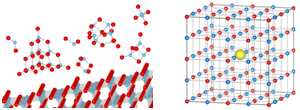MODELLING METAL OXIDES CLUSTERS, BULK AND SURFACES BY QUANTUM CHEMICAL METHODS
WG2 members: Monica Calatayud
homepage: www.lct.jussieu.fr
The main interest in our group is modelling gas-phase clusters, solids, surfaces and interfaces on the atomic level by means of state of the art quantum mechanical tools. We aim at understanding the structure-activity relationship on systems of interest in heterogeneous catalysis, photocatalysis, surface science and materials science. In particular we study the parameters that affect energetics and electronic structure of metal oxides such as relaxation, reconstruction, presence of defects and doping, and their influence in the reducibility and chemical reactivity of the materials.

Left: TiO2 gas-phase clusters landing on a rutile (110)-surface Right: charge density isocontour (yellow) for an oxygen vacancy in MgO.
Systems: TiO2, MgO, ZrO2, V2O5, CeO2, Ga2O3, mixed oxides, gas-phase clusters
Methods and codes available: periodic density-functional theory methods (VASP, CRYSTAL), standard molecular packages (Gaussian), chemical bonding analysis (ELF, NCI)


